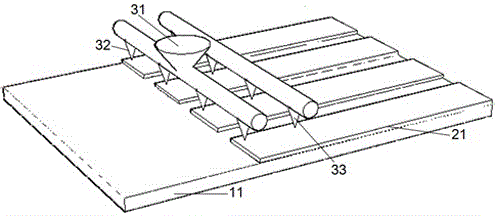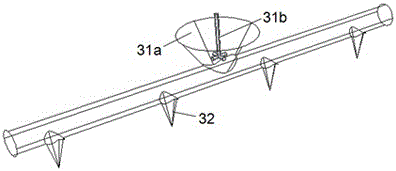A method for preparing transparent conductive electrodes based on 3D printing technology
A transparent conductive electrode and 3D printing technology, which is applied in the manufacture of circuits, electrical components, cables/conductors, etc., can solve problems such as limitations, high growth environment requirements, and poor physical adhesion, so as to reduce production costs, improve the quality rate and The effect of precision and simplification of cumbersome process
- Summary
- Abstract
- Description
- Claims
- Application Information
AI Technical Summary
Problems solved by technology
Method used
Image
Examples
Embodiment
[0032] Refer to figure 1 with figure 2 . This embodiment uses 3D printing technology to prepare a tin-doped indium oxide transparent conductive electrode, that is, an indium tin oxide (ITO) transparent conductive electrode as an example.
[0033] The ITO transparent conductive electrode includes 11 glass substrate and 21 ITO film. The 3D printing device includes 31 sol generating cavity, 323D printing head and 33 laser printing head. The specific 31 sol generating cavity includes 31a sol generating cavity and 31b stirring rod.
[0034] The specific configuration method of the sol used to generate the ITO film is: adding indium chloride, tin chloride, and ethanol to the 31a sol generating cavity in proportion, and then using the 31b stirring rod in the sol cavity to stir the solution evenly. Generate sol. It is characterized in that the molar concentration of indium chloride is 0.15 mol / L, and the concentration ratio of indium chloride to tin chloride is 9:1.
[0035] The present...
PUM
 Login to View More
Login to View More Abstract
Description
Claims
Application Information
 Login to View More
Login to View More - R&D
- Intellectual Property
- Life Sciences
- Materials
- Tech Scout
- Unparalleled Data Quality
- Higher Quality Content
- 60% Fewer Hallucinations
Browse by: Latest US Patents, China's latest patents, Technical Efficacy Thesaurus, Application Domain, Technology Topic, Popular Technical Reports.
© 2025 PatSnap. All rights reserved.Legal|Privacy policy|Modern Slavery Act Transparency Statement|Sitemap|About US| Contact US: help@patsnap.com


